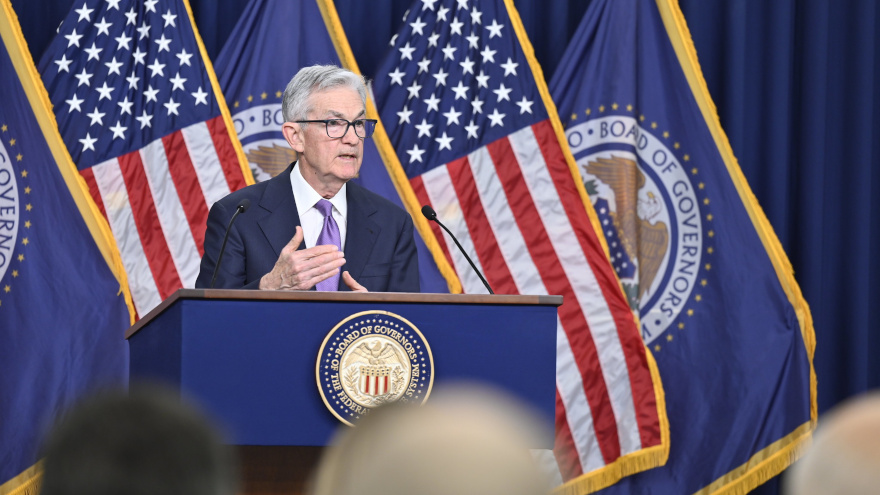After Fed keeps rates steady, business optimism improves while consumers still feel ‘the pinch’

Federal Reserve chair Jerome Powell appears at a news conference on Wednesday in Washington, D.C. Photo courtesy of the Federal Reserve.
With one automotive economist acknowledging consumers are still feeling “the pinch,” some of the largest businesses in the U.S. now have some optimistic expectations for 2024 fueled in part because interest rates might finally have peaked.
The Federal Reserve kept the federal funds rate unchanged at 5.25% to 5.5% when policymakers had their last opportunity of the year to make an adjustment this week.
Fed chair Jerome Powell reiterated multiple times during his opening statement of a news conference on Wednesday that “inflation is still too high, ongoing progress in bringing it down is not assured, and the path forward is uncertain. As we look ahead to next year, I want to assure the American people that we are fully committed to returning inflation to our 2 percent goal.”
Later in his remarks, Powell said, “While we believe that our policy rate is likely at or near its peak for this tightening cycle, the economy has surprised forecasters in many ways since the pandemic, and ongoing progress toward our 2 percent inflation objective is not assured. We are prepared to tighten policy further if appropriate.
“We are committed to achieving a stance of monetary policy that is sufficiently restrictive to bring inflation sustainably down to 2 percent over time, and to keeping policy restrictive until we are confident that inflation is on a path to that objective,” Powell went on to say.
So, if inflation is still hotter than a charcoal grill, why didn’t the Fed continue to pour cold water on it with its interest-rate extinguisher? ADESA chief economist Tom Kontos offered this explanation to Cherokee Media Group.
“In its decision to hold rates, the Fed was aided in the ‘optics’ of inflation by a 6.0% decline in gasoline prices between October and November, which helped limit the overall Consumer Price Index ‘headline’ number to 3.1% growth year-over-year. Even with that aid, inflation remains well above the 2% Fed target,” Kontos wrote in an email.
“In addition, consumers still feel the pinch from prices for most goods and services that are much higher today than they were before the pandemic, including prices for new and used vehicles,” Kontos added.
Perhaps the vehicle price is helping the financing component of deliveries, too. According to the blog post from Cox Automotive chief economist Jonathan Smoke, rates connected to auto financing have declined in December.
Smoke reported the average new-vehicle finance rate approached 10% in October and has ticked down to 9.6%, while the average used-vehicle financing rate hit 14.4% in mid-November and has eased slightly to 14%.
“The Fed has yet to give up on the prospect of pushing rates higher, but their new language indicates that increasing rates further is only an option and not their expectation,” Smoke wrote. “This is as close to being done raising rates without saying, ‘We’re done.’
“High rates clearly limit who can buy expensive goods that require financing,” he continued. “High rates also impact businesses like dealers who carry costly inventory. We could see rates remain high or even increase from where they are today because of the continuing liquidation of the Fed’s balance sheet, otherwise known as quantitative tightening (QT), combined with substantial new debt issuance by the U.S. Treasury. The Fed has not communicated any plans to stop or change the pace of that runoff.
“However, the economy has resisted a recession thus far,” Smoke went on to say. “With lower prices on new vehicles and depreciation returning to used vehicles, affordability has modestly improved despite the increase in rates. Affordability limits demand, but affordability should improve more in 2024 as prices continue to fall thanks mostly to discounts and incentives and as rates hopefully begin to decline as well. It is now a question of when that starts and by how much.”
Rosier overall business outlook
While the latest research from Cox Automotive showed prevalent pessimism among dealerships, results of Provident Bank’s 2024 Economic Outlook that polled owners and executives of businesses in the U.S. with annual revenues of more than $1 million showed general positivity.
The survey conducted by Pollfish, a market research provider, on behalf of New Jersey-based Provident Bank revealed the outlook for both the U.S. economy and respondents’ businesses is positive, with 71% expecting their businesses’ overall outlook to improve and 62% expecting the overall U.S. economy to improve in 2024.
A majority (61%) of respondents expect hiring to increase in the new year due to projected sales growth (52%); reasonable labor costs (39%); a need for skills not possessed by current staff (36%); improved economic outlook (36%); expansion into a new segment or market (33%); and inadequate staffing levels to meet demand (32%).
In addition to inflation — which was ranked by 70% of total respondents as one of the top three challenges facing the nation’s leaders — was climate change (44%); crime (32%); bringing manufacturing back to the U.S. (31%); and national debt (29%).
Additional findings based on 1,000 responses included:
—72% expect to increase capital expenditures for 2024.
—The most widely anticipated challenges facing businesses in the upcoming year include inflation (60%); rising wages (41%); supply chain-related delays and shortages (34%); revenue and sales growth (34%); attracting and retaining talent (29%); and corporate taxes (21%).
—89% of respondents said their businesses had been affected by rising interest rates.
“I’m pleased to see the positive sentiments reflected in our annual economic outlook survey,” Provident Bank president and CEO Anthony Labozzetta said in a news release. “This optimism is a testament to the resiliency of our economy. As bankers, it is important that we have conversations with our customers to identify potential challenges, as well as opportunities in 2024.”


